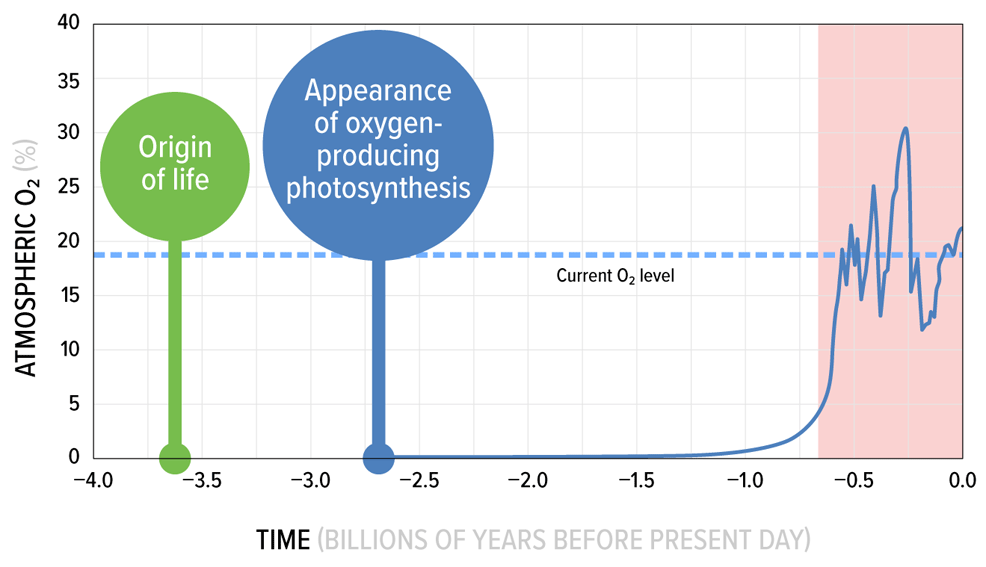
4th September 2023 Low-oxygen planets may impede advanced civilisations Astrobiologists theorise that low-oxygen planets would be unlikely to produce advanced civilisations, as the discovery of fire requires easy access to open air combustion, which is only possible when oxygen partial pressure is above 18%.
When the Earth formed around 4.6 billion years ago, its atmosphere consisted mostly of carbon dioxide, methane, ammonia, and water vapour – with a lack of free oxygen making it totally inhospitable for aerobic life. The first cyanobacteria – photosynthetic organisms releasing oxygen as a waste product – did not emerge until 2.7 to 3.5 billion years ago. A subsequent transformation known as the Great Oxidation Event boosted atmospheric levels of oxygen from tenuous to moderate in a relatively brief time. Leading up to and during the sudden diversification of life known as the Cambrian explosion, oxygen became abundant. Earth's oxygen level peaked as a proportion of the atmosphere at 31% during the Carboniferous period of 300 million BCE. This resulted in the evolution of gigantic insects like Meganeura, a dragonfly-like creature with a wingspan of up to 75 cm (2.5 ft), alongside other oversized arthropods. Forests proliferated around the planet, and enormous wildfires became a frequent occurrence, fuelled by the elevated oxygen levels that facilitated hotter and faster combustion. Following the Carboniferous period, oxygen levels then declined rapidly, eventually stabilising at the modern level of roughly 20% and remaining there for over 100 million years. This was conducive to the controlled use of fire, which Stone Age humans discovered somewhere between 1 and 2 million years BCE.
But what if Earth's oxygen level had been different at the time? Fire ignition becomes strongly inhibited below 18%, while a concentration above 35% makes combustion so easy that vegetation would suffer global damage. Two astrobiologists have published a new paper on this subject. Their insights may improve the search for intelligent life elsewhere in the cosmos, narrowing the range of possible exoplanets on which advanced technospheres like our own world can develop. If the discovery of fire is a crucial milestone for any civilisation to pass through, then the level of atmospheric oxygen might be a "bottleneck" in this process, the authors explain. While planets are likely common in the Universe, planets where the controlled use of fire is possible could be rare. "You may have enough oxygen in the atmosphere of an exoplanet to have complex multicellular life, but you may not have enough oxygen to start combustion," said co-author Amedeo Balbi, from the University of Rome, Italy. Balbi worked with co-author Adam Frank, from the University of Rochester in New York. They suggest that efforts to pinpoint intelligent alien life should focus on planets with an atmospheric oxygen content of between 18.5% to 21%, the optimum range. "The existence of an oxygen bottleneck has significant implications for future searches of technological activities on exoplanets. Target selection might prioritise planets with spectral O2 signatures that are above the combustion threshold," they conclude in their paper. "At the same time, the presence of high oxygen levels (or lack thereof) should serve as a contextual prior to assess the credibility of possible evidences of technosignatures in the data." However, the way life emerges on other planets may be different to Earth, meaning the oxygen bottleneck may not apply. According to Ingo Waldmann from Imperial College London, alien species in a low-oxygen environment might harness heat from geothermal activity to develop smelting, for example – unlike the method of rubbing stones and sticks used by early humans. "That was the evolutionary path we took, but I'm not necessarily sure whether that can be generalised across the Universe." Beyond our own Solar System, oxygen has yet to be detected in significant amounts in the atmosphere of an exoplanet. However, a new generation of telescopes emerging this decade may revolutionise our ability to analyse these distant worlds, potentially offering direct evidence of abundant oxygen – and perhaps within the optimum range proposed by Balbi and Frank. "We're just getting started looking for the atmospheres of terrestrial planets," adds Frank. "This is the exciting thing – we're at the frontier now."
Comments »
If you enjoyed this article, please consider sharing it:
|








